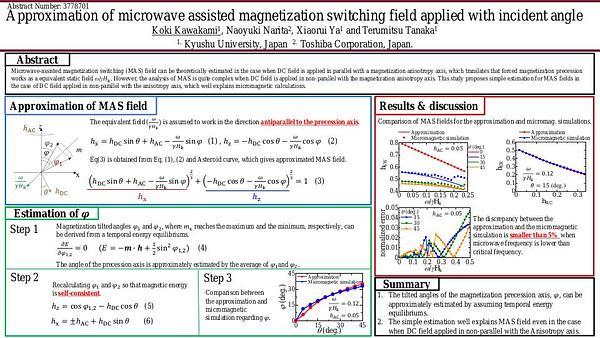Would you like to see your presentation here, made available to a global audience of researchers?
Add your own presentation or have us affordably record your next conference.
Voltage-controlled magnetic anisotropy (VCMA) effect in ferromagnetic ultrathin films is an emerging technology that enables energy-efficient magnetization switching 1,2. Besides, microwave assisted magnetization switching (MAS) technology has also attracted interests as an energy assisted magnetization switching method 3. On the other hand, microwave voltage applied to a VCMA gate on an ultrathin ferromagnetic nanowire results the parametric excitation of magnetization precession and propagating spin wave 4. In this study, we numerically demonstrated AC voltage-induced magnetization switching, which showed magnetization switching was well assisted.
Fig. 1(a) shows the schematic illustrations for the ferromagnetic nanodot covered by a dielectric layer. DC bias magnetic field (Hb) was applied at θ with respect to the anisotropy axis. The voltage-induced modulation of the anisotropy was numerically modeled by the local sinusoidal ΔHk-change with the amplitude of 0.1Hk. The dependence of the precession amplitude on the excitation frequency fexc when Hb close to the switching field at various incident angles is plotted in Fig. 1(b). Two resonance peaks are observed, which represent the ferromagnetic resonance (fexc = fprecession ) and the parametric resonance (fexc = 2fprecession). The parametric resonance presents a typical spectrum that the precession amplitude abruptly increases with frequency. Fig. 1(c) presents the dependence of switching fields on the excitation frequency as a parameter of the field incident angle. When the field applied non-parallel to the anisotropy axis, the switching field shows two local minima, which are due to the resonances in Fig. 1(b).
The comparison of the switching fields among the 3 different switching methods is shown at Fig. 2. The switching field with AC voltage-induced method is 35% smaller than magnetic field only, demonstrated that the AC voltage-induced method assist magnetization switching well.
References:
1 T. Yamamoto, et al., Phys. Rev. Appl., Vol. 13, p.014045 (2020).
2 J. Liu, et al., J. Magn. Magn. Mater., Vol. 513, p.167105 (2020).
3 J. Zhu, et al., IEEE Trans. Magn., Vol. 44-1, p.125-130 (2008).
4 R. Verba, et al., Sci. Rep., Vol. 6, p.25018 (2016).

Fig. 1 (a) The schematic illustrations for the ferromagnetic nanodot covered by dielectric layer. Dependence of the precession amplitude (b) and the switching field (c) on the excitation frequency.

Fig. 2 Comparison of the switching field among 3 different methods.
